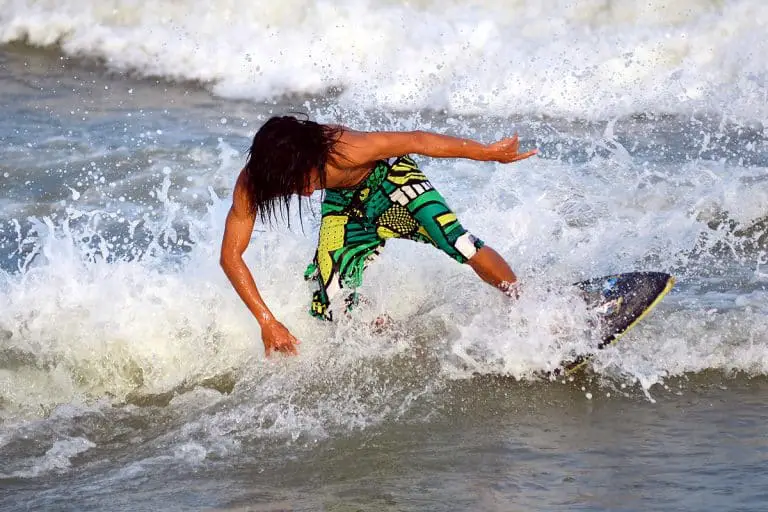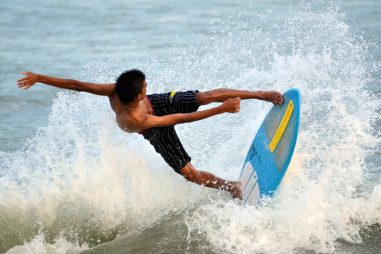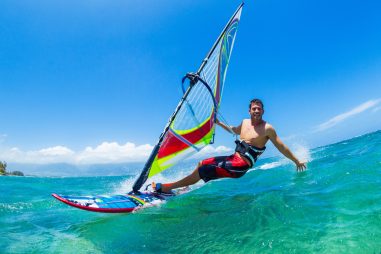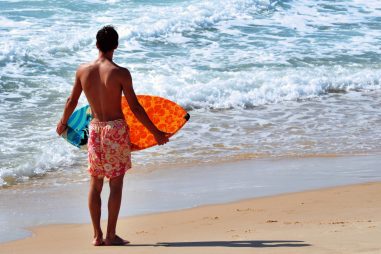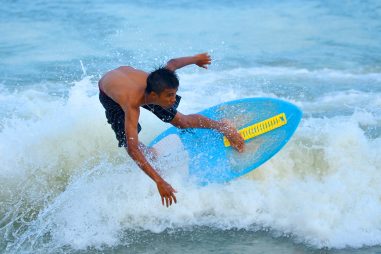Since skimboarding is done in shallow water, skimming on flat water can be easier for people of different ages. Although it may look easy, catching a wave on a skimboard can be a little trickier. Surfing, on the other hand, takes more time to learn and needs a lot of effort to perform. You will need to be a good swimmer to safely enjoy surfing as it is more life-threatening to catch waves in the deeper part of the ocean.
Is Skimboarding Like Surfing?
Riding wave is one of the few similarities between skimboarding and surfing. While surfers try to ride a wave far from the shore, skimboarding catches incoming waves near the beach. Racing to catch a wave is a common scenario on a crowded beach. Always remember to share waves with surfers and other beachgoers so everyone will have a fair share of fun.
Surfboard and skimboard are built differently, but both are usually made out of wood or fiberglass. These materials are proven to be the most suitable option for surfing and skimboarding activities. A major highlight of skimboarding is performing cool tricks. It will be a huge advantage for someone who spends a good amount of time surfing as you would surely use balance and control in executing skimboarding tricks.
What Is the Difference Between Skimboarding and Surfing?
Despite the fact that both sports are somewhat alike, skimboarding and surfing have a tremendous difference. From board to its execution, skimboarding and surfing difference greatly outweighs their similarities. Below is a list of differences between the two unique water-based sports:
- Boards: Skimboard is built without a fin box and doesn’t use fins. This makes the board more difficult to balance and control. When looking at a skimboard, it is also quite apparent that it is shorter, thinner, and narrower than a regular surfboard.
- Waves: Catching big waves is necessary for surfing. It is also usually more challenging and exhausting to get on a wave while surfing. On the other hand, skimboarding is more flexible and can be enjoyed with or without a wave.
- Location: Surfing is best enjoyed in deep parts of the ocean. Most surfers position themselves a little over the front, where the swell starts to catch waves. For skimboarding, the beach shore where the waves break is the perfect spot.
- Riding style: There are lots of ways you can ride your surfing board. You can stand with your feet, use your knees or even lie on your stomach. But for skimboarding, jumping on top of your board with your feet is the most usual stance.
Is Skimboarding Easier or Harder Than Surfing?
Both these extreme water sports are challenging in their own ways. There is a need for a certain level of physical fitness and decent sportiness to improve these two activities continuously. Catching an incoming wave is harder to do in skimboarding; while it may look easier to get on a wave in surfing, it will take a lot of effort to get on top of a wave when surfing.
Beginners can practice a lot while starting skimming since it can be performed in any water condition. It is also easier to learn skimboarding and perform simple tricks at the beach. As both sports have a steep learning curve, it will take time and a lot of practice for you to become a pro in this sport.
Is Skimboarding More Dangerous Than Surfing?
Both surfing and skimming are dangerous in their own ways. It may look the other way around, but it is a fact that you can most likely get injured when doing skimboarding. Since skimboarding is done in shallow water, you have a higher risk of getting a bruise or broken bones from hitting the floor.
Although you can get hurt a lot in skimboarding, surfing is still more life-threatening activity. Because surfers need to catch a wave from the deep part of the ocean, they have a higher risk of getting drowned. Sudden change in current, strong waves, and other sea life is also a threat for most surfers.
Can You Surf With a Skimboard?
It is possible to surf using a skimboard, but it will be challenging and exhausting. Many surfboard characteristics are missing from a skimboard that makes it not ideal for surfing. Unlike surfboard, skimboards don’t have fin slots. The absence of fins makes skimboards more difficult to control and balance in the water.
Skimboards are also less buoyant than surfboards which can be hard to ride in deep waters. Another factor is skimboard size, and it is evident that surfboards are longer and wider than a skimboard giving it more stability and drag for surfers. Even if there is a huge difference in the boards, it is still viable for an experienced surfer to use skimboard for surfing.
Does Skimboarding Help With Surfing?
Most water-based sports can aid you in learning and mastering surfing. Skimming, a very related sport to surfing, can be a massive help before going out to surf. Most young people learn first to skim before they try to surf. This is because skimboarding is a more child-friendly sport than surfing.
Skimboarding can help you gain an additional understanding of the waves and increase your wave selection judgment. Since skimboards don’t have fins, this can also assist you in improving your balance and learn to use the tail more effectively. Practicing both skimming and surfing can give you a new perspective on these sports.

